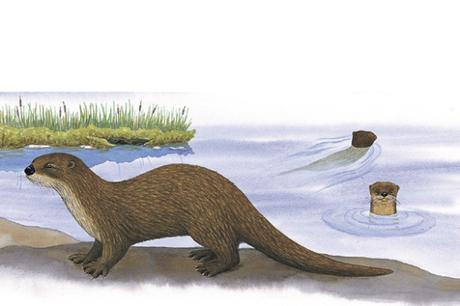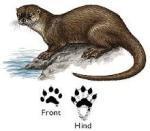
Credit: painting by Consie Powell from Kays and Wilson’s Mammals of North America, © Princeton University Press (2002)
The North American River Otter (Lontra Canadensis) is a dark brown, long-bodied, web-footed, big-whiskered mammal weighing between 10 and 30 pounds. Otters live in burrows beside streams, lakes, swamps, and ponds. They are superb fishermen, but they also hunt frogs, turtles, crayfish, small mammals, and birds.
Importance
Like other predators, Otters help control the numbers of their prey species. They happily take introduced alien species along with natives. In a few instances, people have complained that River Otters might be eating trout introduced to Arizona waters for sport fishing.

Otters often eat and sleep floating on their backs. In the picture, a mother is holding her big-footed child on her stomach.
Habitat

Conservation
Prior to the arrival of European settlers, River Otters lived throughout Arizona. Nineteenth Century fur trappers removed most of the Otters, and during the 20th Century, water pollution and stream diversion for irrigation, flood control, and recreation eliminated most of its habitat. Today there are few if any otters left in the State. Ponds and pools along the Agua Fria River in central Arizona are suitable for otters, but it is unlikely that any live here.
Bringing Otters back to Arizona: Reservoir Dreams
Returning Otters to Arizona would be difficult. Otters are sensitive to water pollution, and could not survive in many of the State’s streams and lakes. Moreover, the banks of irrigation canals and reservoirs aren’t suitable for Otter burrows. We can imagine that one of our reservoirs could be set aside for Otters. Stocked with native fish, protected from pollution and recreation, and planted with preferred vegetation, Otters brought to the reservoir from other locations might set up a colony and the species might once again thrive in Arizona.
The header image is from Animal Photos.
Resources
- Arizona Game and Fish Department (AZGFD). List of “nongame” species includes bats: http://bit.ly/YOa6og.
- Arizona Game and Fish Department. 1995 (Second Draft). Animal Abstracts Lontra Canadensis sonora. PDF. Unpublished abstract compiled and edited by the Heritage Data Management System, Arizona Game and Fish Department, Phoenix, AZ. PDF.
- Hoffmeister, D.F. 1986. Mammals of Arizona. The University of Arizona Press. Tucson. Pp. 515-517.
- Jones, et al. 1987. North American Mammals North of Mexico. Texas Tech Univ.
- Kays, R.W., and D.E. Wilson. 2009. Mammals of North America (second edition). Princeton Univ Press, Princeton, NJ. 248 p.
- National Wildlife Federation: www.nwf.org.
- NatureServe. http://www.natureserve.org/explorer.
- Navajo Nation Fish and Wildlife Department. 2000. Navajo Endangered Species List. Navajo Nation Fish and Wildlife Department. 2005. Navajo Endangered Species List. P. 2.
- Smithsonian National Museum of Natural History: http://www.mnh.si.edu/mna/image_info.cfm?species_id=142.
- Tesky, J.L. 1993. Lutra canadensis. In U.S. Department of Agriculture, Forest Service, Rocky Mountain Research Station Sciences Laboratory (2002, September). Fire Effects Information System, http://www.fs.fed.us/database/feis/animals/mammal/luca/all.html.
- Endangered Species Act. 1973. The act and related laws discussed at: http://www.fws.gov/laws/lawsdigest/ESACT.html.
- U. S. Fish and Wildlife Service: http://www.fws.gov.
- USDA, Forest Service Region 3. 1999. Regional Forester’s Sensitive Species List. (The latest update (2007) does not list the River Otter).

